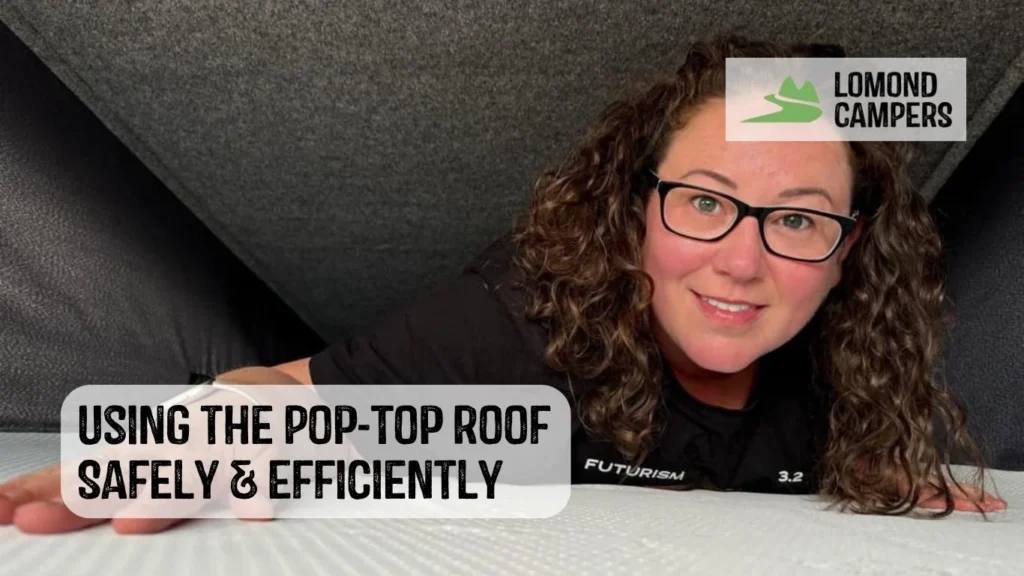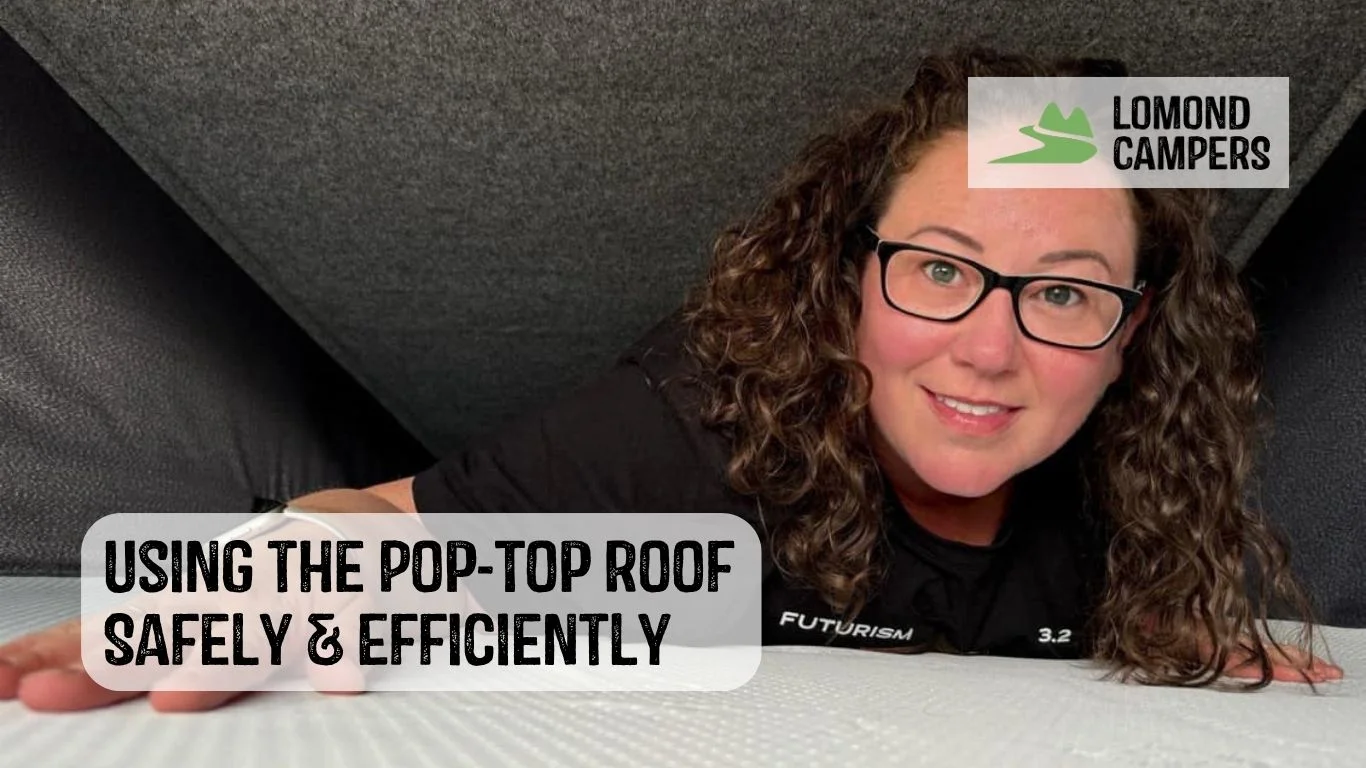Applies to most front-hinged or rear-hinged systems (e.g., Reimo, SCA, Drivelodge). Always follow your roof’s own manual if anything differs.
Quick-start (1 minute)
- Park safely: engine off, handbrake on, check for branches/garages above.
- Unlatch both catches (front or rear depending on hinge).
- Push up centrally with steady pressure; gas struts will assist.
- Tidy the bellows: pull fabric outward so it’s smooth in the corners.
- Lower to close: pull the strap with one hand while guiding fabric in with the other; latch both catches fully; quick walk-round before driving.
Safety first (always)
- Vehicle secure: parked on level ground if possible; engine off; handbrake on.
- Overhead clearance: avoid tree branches, soffits, low carports and garage doors.
Why: damage to the shell, fabric and seals is common from hidden branches. - Hands & fabric clear of scissor arms and hinges.
Why: moving mechanisms can pinch. - Wind guidance: avoid raising in strong winds (roughly > 25–30 mph); use approved storm straps only if your manufacturer allows.
Why: high winds strain struts, hinges and fabric and can slam the roof. - Never drive with the roof even partly raised.
Why: severe risk of damage and loss of control.
Raising the roof (step-by-step)
- Release both latches evenly (front-hinged roofs usually latch at the front, rear-hinged at the rear).
- Push centrally and smoothly until fully up.
Why: even pressure protects the hinges and keeps the shell square. - Seat the weather flap and tension the bellows:
- Gently pull the fabric outwards at each corner.
- Check there are no deep creases.
Why: neat bellows shed water properly and reduce wind noise.
Tip: If it feels heavy, check a latch isn’t still half-on. Don’t force it.
Using the roof bed
- Bed board up = headroom. Lift or slide the board (model-dependent) to stand in the galley.
- Bed board down = sleeping mode. Use the supplied mattress.
- Weight limit: typically ~150–200 kg total, but check your roof’s plate/manual.
- Condensation control: crack a side window or roof vent slightly; consider a breathable underlay beneath the mattress.
Why: improves airflow, reduces damp patches and mildew.
Child safety: supervise climbing; no jumping on the bed; ensure the ladder is stable.
Closing the roof (step-by-step)
- Clear bedding from hinges and scissor areas; nothing bulky on the board.
- Pull-down strap: one hand on the strap, the other sweeps fabric inward all around as the roof descends.
Why: keeps bellows from pinching and preserves the seals. - Latch both catches fully and check they’re seated.
- Walk-round check: bellows not protruding; no straps trapped; roof shell flush with the body.
Why: avoids water ingress and wind lift.
Cold-weather tip: If canvas is wet or frosty, defrost and dry before long-term storage to prevent mildew and stuck zips.
Weather, warmth & comfort
- Ventilation: always leave a small vent gap at night to reduce condensation.
- Thermal kit: insulated wraps or liners improve warmth and reduce morning condensation.
- Rain: well-tensioned bellows shed water better. Avoid rubbing the fabric against sharp edges.
- Snow/ice: do not raise with snow load; clear and thaw first.
Why: extra weight strains struts and hinges.
Care & maintenance (simple routine)
- Bellows (fabric):
- Brush off loose debris regularly.
- Spot-clean with mild soap (no harsh detergents/bleach).
- Re-proof annually with the manufacturer-approved spray.
Why: maintains water repellency and fabric life.
- Seals: inspect for tears, flat spots, trapped grit. Wipe clean; treat lightly with a silicone care stick.
Why: supple seals keep drafts and water out. - Hinges/struts: visual check of fixings and mounts every few months; if you notice play, squeaks or uneven lift, book a converter inspection.
- Zips & windows: keep sand/grit out; occasionally lube zips with a dry zipper lube.
Cleaning caution: avoid pressure-washing directly at seals or under the shell. Hand-wash is kinder.
Troubleshooting (quick fixes)
- Roof won’t raise smoothly:
- Check both latches are fully released.
- Ensure van is roughly level; heavy front/back lean can bind hinges.
- Cold weather? Warm the canvas slightly and try again.
- Fabric keeps pinching on close:
- Use a “C-sweep”: one hand pulls the strap, the other sweeps the canvas inward in a continuous circle.
- Ask a second person to guide corners for the last 20 cm.
- Won’t latch flush on one side:
- Check for trapped fabric or bedding.
- Confirm both latches are adjusted equally (follow your roof manual).
- Inspect seals for folds or debris.
- Wind noise after closing:
- Reopen a few centimetres, re-seat the bellows and seals, close again.
- Check that the weather flap is lying correctly.
Good habits (why they matter)
- Even, central push to open; even, guided pull to close → protects hinges/struts and fabric.
- Bellows tidy every time → less water ingress, less wind noise.
- Latched and walk-round check before driving → prevents costly damage.
- Dry before storage → avoids mildew and odours.
Need Help?
If anything feels unclear at a site, don’t struggle—we’re happy to help.
- Email: info@lomondcampers.co.uk
- Book an appointment: lomondcampers.co.uk



